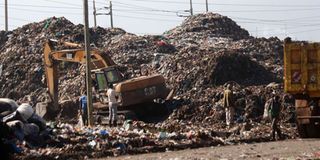Cooperatives can help to address Kenya’s high energy prices

Activity at the Dandora dumpsite in Nairobi in November last year. The eyesore can be turned into a source of clean energy.
A recent review of Kenya’s energy sector revealed that hydropower accounts for about 52.1 per cent of total production followed by thermal (fossil fuel, 32.5 per cent), geothermal (13.3 per cent) and biogas, wind and solar.
The Lake Turkana Wind Farm, Africa’s largest, injects 310 megawatts into the national grid while the solar farm in Garissa County, the largest in the region, contributes 50MW.
The cost of energy is of great concern. This is largely because energy is a means to survival just as much as it is to development. Energy, in its various forms — wood fuel, fossil fuels, biomass, biogas, solar, wind, hydropower and so on — is used for lighting, heating and cooking. Without it, we are doomed. Energy is also used to run industrial plants and transport. When a country faces an energy crisis, it’s double-edged: Survival and development.
In March, the household cost of electricity was $0.233 (Sh23) per kilowatt-hour (kWh). The country was ranked the most expensive energy supplier, compared to Uganda ($0.19) and Tanzania ($0.1), the cheapest. Dear energy means lack of life’s basics.
Following an outcry over costly energy, particularly fuel prices, Parliament’s Energy committee summoned the relevant parties. Never mind that the Energy and Petroleum Regulatory Authority (Epra), responsible for determining month-on-month fuel prices, applies a formula supplied courtesy of the same MPs!
In March, President Kenyatta constituted a team to review power purchase agreements (PPAs) signed over the years between Kenya Power and independent power producers (IPPs). Then, energy prices shot up but the power distributor’s balance sheet was increasingly in the red.
In September, the committee recommended in its report a review of PPAs to pave the way for cost reduction by a third. Consequently, the President ordered cancellation of all PPAs and reassigned the Energy ministry’s top officials.
The potential solution to high energy prices lies in energy cooperatives. Operating in many communities in Europe, energy cooperatives fund renewable energy solutions through community share issues.
Community members’ access at lower cost the energy generated from roofs of community buildings, the local economies benefit from retention of revenue in the community and the environment benefits from reduced green gas emissions.
Any excess energy is sold to utility companies. The excess funds generated from the projects are often channelled to community funds to support other activities.
In Kenya, the existing cooperatives could establish an arm to handle energy concerns. Although there are efforts in this, cooperatives have not moved fast enough into the gap created by high energy costs. Some cooperatives, especially the Coffee Cooperatives, have diversified their activities into producing charcoal or biochar.
With support from the We Effect, a Swedish Cooperative Development partner operating in Kenya, they convert coffee husks to charcoal and sell it as an additional source of income. The charcoal could also be used as a lower-cost energy alternative to fossil fuels for drying or roasting of coffee beans.
Energy cooperatives could use mounds of green waste generated in urban centres to generate energy. For example, the organic markets in Nairobi — Wakulima Market, Gikomba Market, City Park Market and City Market — produce a combined 19 tonnes of organic waste per day. Think of Mombasa’s Kongowea, Kisumu’s Kiboswa, Kisii’s Daraja Mbili and many more markets across Kenya.
With careful planning, this waste can be used to generate gas, electricity and heating. Additionally, the end-of-line waste produced can be prepared and packaged as manure and sold for gardening and farming.
The technology to do this exists and has been refined over time. We know from elsewhere that the waste-to-energy plants reduce about 900 kilogrammes of garbage to ash weighing 136-270kg and reduce the volume of waste by about 87 per cent.
Think of what this could do to our Dandora dumpsite in Nairobi.
Prof Nyamongo, an anthropologist and Fulbright Scholar, is a deputy vice-chancellor at The Cooperative University of Kenya. [email protected]. @Prof_IKNyamongo





